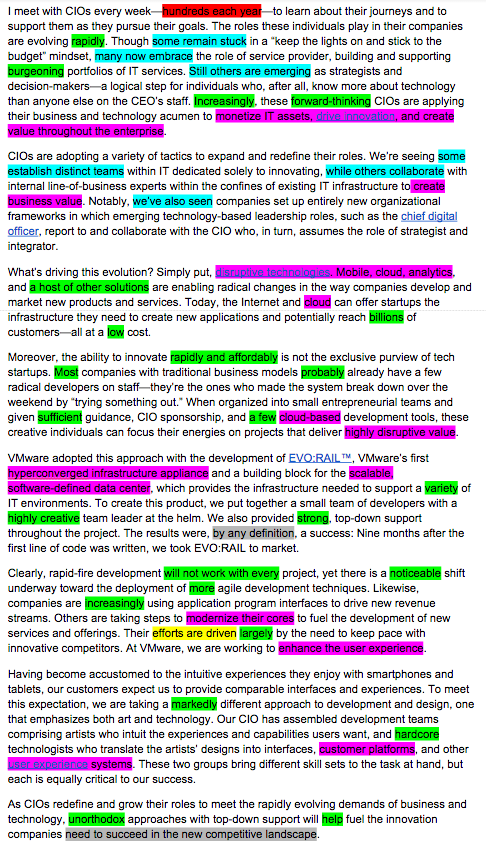VMware / Deloitte “native advertising” makes delicious waffles
 If you like sausages, don’t ask how they’re made. But I’m happy to explain how waffles are made, including this piece about CIOs from the Wall Street Journal, titled “CIOs Redefining Role to Fuel Integration, Innovation.”
If you like sausages, don’t ask how they’re made. But I’m happy to explain how waffles are made, including this piece about CIOs from the Wall Street Journal, titled “CIOs Redefining Role to Fuel Integration, Innovation.”
VMware, the technology company, wants to impress CIOs. CIOs read articles in the Wall Street Journal‘s “CIO Journal” section. But in case you can’t get coverage in the CIO news, there’s a space right next to it that has what looks like more articles. These are “native ads” — ads that mimic content. Deloitte Consulting bought that ad space. Since Deloitte sells “solutions” based on VMware, it’s no stretch for VMWare to publish “articles” in Deloitte’s paid space.
But who writes those “articles?” As a VMware representative explained it to me, although the article’s byline reads VMware CEO Pat Gelsinger, someone from VMWare’s PR or marketing department actually wrote it. It goes from VMware to Deloitte, and on to the Journal. The Journal puts this disclaimer in small type at the top of the section:
CONTENT FROM OUR SPONSOR
Please note: The Wall Street Journal News Department
was not involved in the creation of the content below.
 So this piece is unencumbered by rules of journalism, and need not be balanced. VMware had the chance to just say whatever it wanted, proudly. But instead, we get waffles: weak prose that fails to take a stand. (In the Google doc shown here I’ve highlighted weasel words in green, jargon in magenta, passive voice in yellow, and wishy-washiness in cyan.) Here are three key weaknesses:
So this piece is unencumbered by rules of journalism, and need not be balanced. VMware had the chance to just say whatever it wanted, proudly. But instead, we get waffles: weak prose that fails to take a stand. (In the Google doc shown here I’ve highlighted weasel words in green, jargon in magenta, passive voice in yellow, and wishy-washiness in cyan.) Here are three key weaknesses:
1 Weasel words galore. Gelsinger’s ghostwriter can’t make a statement without qualifying it:
Most companies with traditional business models probably already have a few radical developers on staff . . . rapid-fire development will not work with every project . . . companies are increasingly using application program interfaces. . . Their efforts are driven largely [and apparently, passively] by the need to keep pace with innovative competitors.
2 Everybody’s different. In an attempt to be inclusive, the article describes every possible strategy. “I once saw a CIO like this, and another one like that . . .”
Though some remain stuck in a “keep the lights on and stick to the budget” mindset, many now embrace the role of service provider . . . Still others are emerging as strategists and decision-makers . . . some establish distinct teams within IT . . . we’ve also seen companies set up entirely new organizational frameworks . . .
3 The big fizzle. Here’s the grand conclusion:
As CIOs redefine and grow their roles to meet the rapidly evolving demands of business and technology, unorthodox approaches with top-down support will help fuel the innovation companies need to succeed in the new competitive landscape.
Thanks. Now that I know that, I’m all set to innovate!
Lessons: For the reader: watch out for native advertising, don’t confuse it with journalism. And for the author: if you get a chance to write one of these, take a stand, don’t waffle.
Short version: When you remove the waffling from this piece, here’s what’s left:
CIOs can innovate and disrupt their own businesses. The CIO has to create political cover for a small, agile development group. That’s what we did at VMware. Your mileage may vary.
If you got this far, I’m sharing a little video treat below: John Oliver’s clever take on native advertising.
Thanks to Forrester analyst and former colleague David K. Johnson for sending this one my way. Right now I’m seeking internal memos that are bulging with bullshit. Send me yours — I’ll keep the company and the source confidential.
Photo: Jonathan Macintosh via Flickr
2 Comments